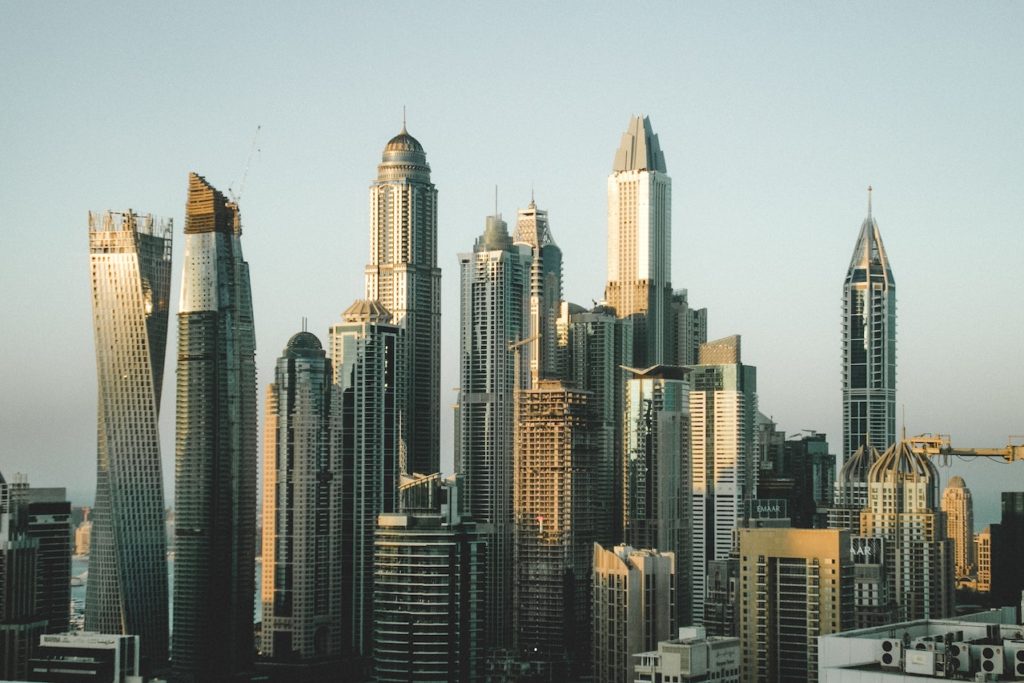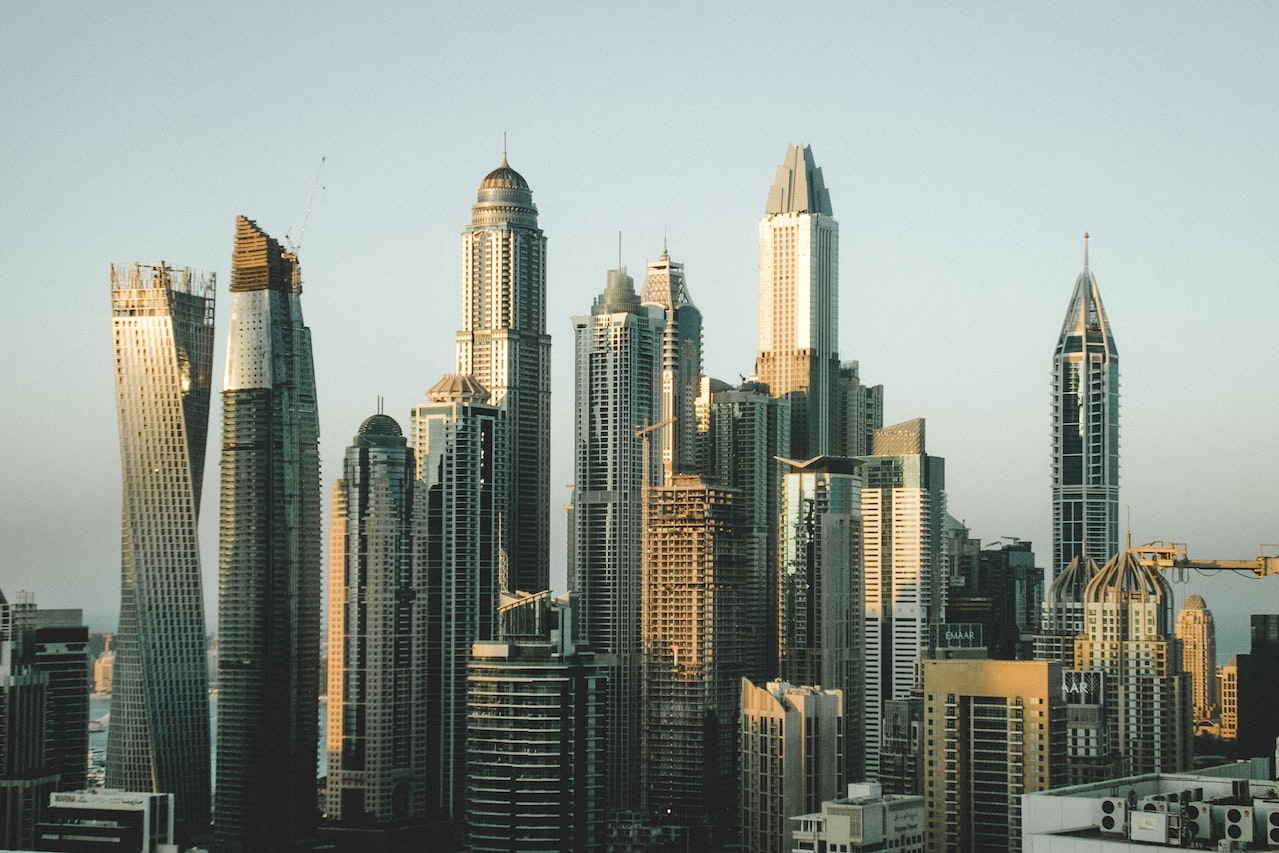
How tall could a skyscraper be? Theoretically 69.1 km tall, but practically, about 2 km.
The tallest building in the world at the moment is the Burj Khalifa. It is 830 meters tall. For over 3800 years, the tallest building in the world was the Great Pyramid at Giza. It was 147 meters tall when it was built, but the stone on the top of it was removed so it is only 147 meters tall now. It was built in roughly 2550 BC and it was the tallest building until the 160-meter-tall spire of Lincoln Cathedral was built in 1311. Tall buildings were generally impractical and the only purpose they served was to be noticed. They were symbols. Until the invention of the elevator, it was impractical to build above eight stories because that was about the limit to how far people would willingly walk up stairs. Unlike today, the most expensive apartments were on the first floor. Building materials were also not strong enough to support the weight. The Great Pyramid had to be made of solid stone.
Two things changed everything. The invention of the elevator and the invention of a way to mass produce strong steel. The first skyscraper was built in 1885. It was the Home Insurance Building in Chicago and it was 10 stories tall. It was built on a steel frame. The steel weighed one third as much as a brick building and people were so worried they thought it would blow over. This started a rush to build tall buildings in America. After the Civil War, there was more money in the North and the economy was rapidly changing from agriculture to white color. More people were living in cities and there was more call for office space. Buildings began to get taller and taller. Incidentally, as an aside, very tall buildings are not made of steel because steel has a vibration problem. At the top of a skyscraper, it would vibrate so much that people would become seasick. Tall buildings are made from concrete and glass because concrete is cheaper than steel, vibration-dampening, and it is incredibly strong under compression.
Today, August 14th 2022, the tallest building in the world is the Burj Khalifa, but the Jeddah Tower is being constructed in Saudi Arabia and it is planned to be at least 1 km tall. So, how tall could a skyscraper be? There are two things to think about. First, we need to consider how much weight modern building materials can support. Secondly, we need to consider what things would stop a building being very tall.
How much weight can modern building materials support? The best concrete to use is high-silica, low aggregate, UHPC-3. It is the strongest concrete available and is lighter than regular concrete. If a building was built in a cone shape, or using buttresses like the Eiffel Tower, the mass of the building could quite easily be supported so long as the bae was wide enough. The area of the base has to double for every 3.1 km of vertical height. The building wouldn’t be solid, like the Great Pyramid, but 60% of the space would be for living space and the support structure. That means, if the base of the cone was 208 km2, the building could be 69.1 km tall. However, 208 km2, is about the size of the city of Boston, so you would need the space of a city to build this megabuilding.
So, is this practical? How tall could a skyscraper be? There are several things that stop a building from being too tall. The first is the wind. The wind speed increases with height from the ground. This is because the pressure gradient between warm air and cold air increases the higher something is. There are also more objects to block the wind closer to the ground. Tall buildings can also cause wind vortexes, where the wind swirls around the building and makes it rock back and forth.
The pressure is another problem. As buildings get higher, the outside pressure can be lower than the inside pressure. In modern skyscrapers, fans equalize the pressure, but if a building was taller than 2 km, this might become a problem. There is also less available oxygen as we go up into the atmosphere. At sea level, 20.9% of the air is oxygen. At 2,134 m, that has fallen to 16.6%. It is feasible that people might get altitude sickness just going up a building like this. Any higher, and the rooms would need to be oxygenated.
All of these problems can probably be overcome, but the two biggest problems are reasons why we won’t see buildings over 2 km tall. The first is elevator space. The taller a skyscraper is, the more elevators it requires. A single elevator cannot get to the top of an enormous skyscraper because the weight of the elevator’s cable is too much for the winch motor to haul. That means elevator banks are needed. The more elevators a building has, the less space there for offices or apartments. Plus, people would have to wait a long time for an elevator.
The second reason is money. Tall buildings obviously cost a staggering amount of money. The Burj Khalifa cost $1.5 billion and the Jeddah Tower will be similar. A 2 km building would cost close to $2 billion and anybody that pays that needs to recoup the money. A building that tall just simply wouldn’t be possible.
So, how tall could a skyscraper be? In theory, there is no real limit so long as the base can expand. However, wind, pressure, oxygen levels, elevators, and money are all reasons why we probably won’t see buildings over 2 km tall. And this is what I learned today.
Sources
https://en.wikipedia.org/wiki/Jeddah_Tower
https://wildsafe.org/resources/ask/altitude-safety/oxygen-levels/
https://www.bloomberg.com/news/articles/2012-08-16/is-there-a-limit-to-how-tall-buildings-can-get
https://en.wikipedia.org/wiki/Early_skyscrapers
https://en.wikipedia.org/wiki/Home_Insurance_Building
https://en.wikipedia.org/wiki/Skyscraper
http://www.rebresearch.com/blog/how-tall-could-you-make-a-skyscraper/
https://www.bbc.com/future/article/20140530-how-high-up-can-skyscrapers-go
https://www.allthescience.org/how-tall-can-skyscrapers-be.htm

